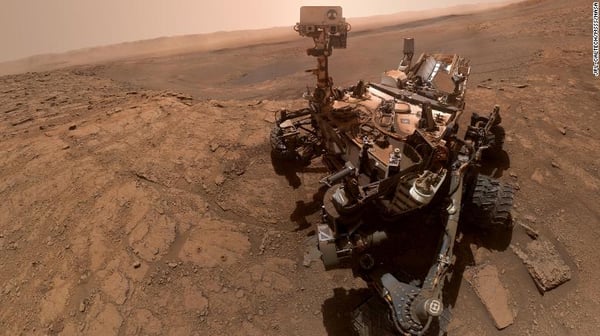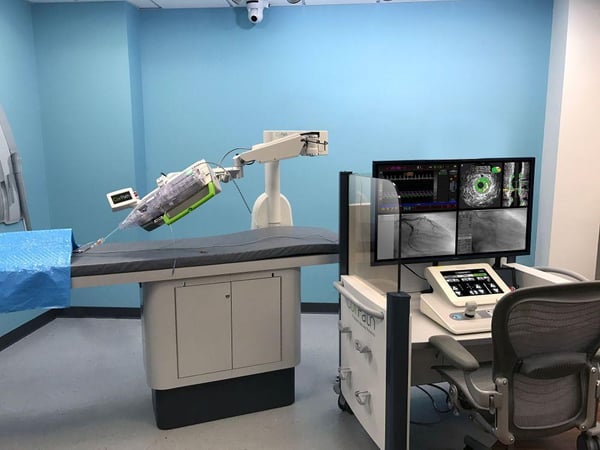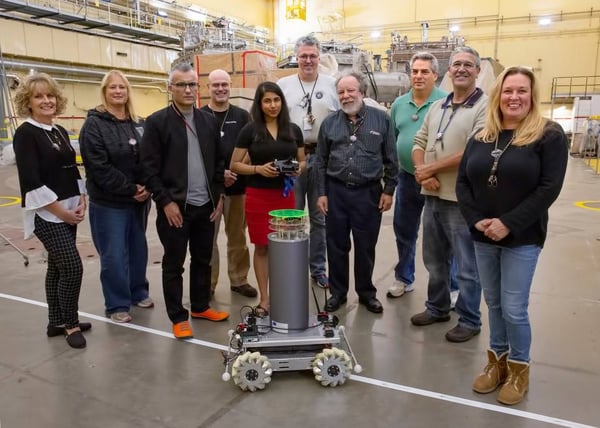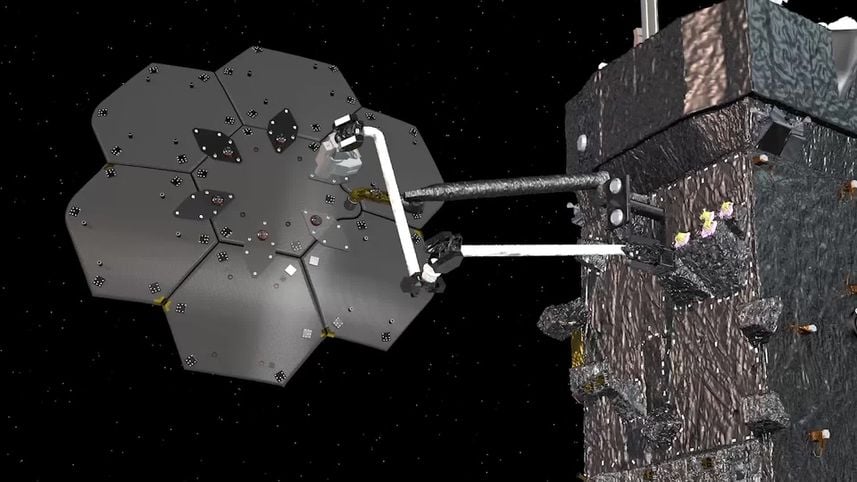What's New In Robotics? 15.11.2019

Posted on Nov 15, 2019 10:29 AM. 8 min read time
Good morning. In this week's news mix: Veo Robotics releases FreeMove, Cummins announces cobot expansion and researchers unveil a cobot system for haptic feedback in VR. Elsewhere, Curiosity Rover discovers oxygen surprise in Martian atmosphere, Princeton develops a robotic nuclear inspector, ingenious Japanese bot climbs ladders and much more!
Cobots & manufacturing
Veo Robotics officially released an SDK for its FreeMove software on Tuesday. Designed to enable human-robot collaboration using traditional industrial robots, FreeMove enables traditional bots to detect humans and slow down its operating speed in response. (H/T The Robot Report)
Via Veo Robotics:
Customers who would like to begin designing and evaluating manufacturing process steps incorporating FreeMove today can purchase the FreeMove Application Development Kit [...] a version of FreeMove running on non-safety-ratable hardware that must be used with redundant safety systems for development purposes. The resulting designs can be implemented in production with the full Veo FreeMove system.
Following the successful deployment of cobots across its global manufacturing facilities from India to the United Kingdom, Cummins has announced plans to more than double the number of collaborative robots it uses by the end of 2019.
 Cummins' Darlington Engine Plant in the UK is using this cobot for quality
Cummins' Darlington Engine Plant in the UK is using this cobot for quality
improvements and managing parts proliferation. Credit: Cummins
Via Autocar Professional:
“As I walk through our diverse plants today, I see opportunities for applying collaborative robot technology every few feet,” said Elizabeth Hoegeman, Cummins Executive Director – Global Manufacturing Engineering. “Our vision is to steadily invest in cobots over the next several years until we exhaust viable applications.”
We've seen cobots used in all sorts of applications over recent years, but video released this week showcases an intriguing new use case --providing high-fidelity haptic feedback and shape rendering in virtual reality environments...
- Robot overlords? More like co-verlords. The future is human-robot collaboration (Digital Trends)
- Using Natural Language in Human-Robot Collaboration, with Brad Hayes (Robohub)
- How Humans Tell Robots What to Do (Robotics Business Review)
- Can robots be automated for more complex workspaces? (USC Viterbi Center for Advanced Manufacturing)
- Adidas to close German, U.S. robot factories (Reuters)
Elsewhere...
NASA's Curiosity rover has discovered fluctuations in the levels of atmospheric oxygen on Mars that researchers are "struggling to explain." A study published Tuesday in Journal of Geophysical Research: Planets found that oxygen rose by a peak increase of 30% in the spring and summer before dropping back to normal levels in the fall. Scientists aren't quite sure why.
 A selfie taken by the Curiosity rover in October 2019. Credit: NASA
A selfie taken by the Curiosity rover in October 2019. Credit: NASA
Via CNN:
"The fact that the oxygen behavior isn't perfectly repeatable every season makes us think that it's not an issue that has to do with atmospheric dynamics. It has to be some chemical source and sink (of elements into the soil) that we can't yet account for," [said Melissa Trainer, planetary scientist at NASA's Goddard Space Flight Center].
A team led by Dr. Vitor Mendes Pereira, a neurosurgeon at the Toronto Western Hospital, has completed an in-human robotic-assisted neurovascular intervention for the first time using a medical assistant bot developed by Corindus.
 Credit: Corindus
Credit: Corindus
ZDNet reports:
The implications for this robotic brain surgery are huge, heralding a transformation of the way surgeons treat things like aneurysm and stroke. That will particularly be the case once 5G becomes a reality, opening up the possibility that surgeons will be able operate these robots remotely, potentially bringing unprecedented access to care worldwide.
Researchers from the Princeton Plasma Physics Laboratory and Princeton University have created a prototype robot that can identify sources of nuclear radiation and determine whether said sources have been shielded to avoid detection. The developers hope that their remote-controlled prototype, which was unveiled this week, will eventually led to the creation of a mobile, fully autonomous neutron detecting swarm.
 The new neutron-detecting bot with its developers. Credit: Elle Starkman, Princeton Plasma Physics Laboratory
The new neutron-detecting bot with its developers. Credit: Elle Starkman, Princeton Plasma Physics Laboratory
Via Princeton News:
The now-calibrated “inspector bot” consists of a cylinder of polyethylene plastic containing three neutron counters set 120 degrees apart and mounted on a robot with specialized wheels that enable it to move in any direction. The detectors, designed by Goldston and Moritz Kütt, a former postdoctoral Princeton researcher, provides both high sensitivity to the energy of detected neutrons and the direction from which neutrons are coming. Low energy could indicate shielding.
- This technology will transform you into Superman (Norwegian SciTech News)
- Drones will swarm our skies when these 3 things happen (c|net)
- The robots are coming, faster than ever (Boston Globe)
- Fun New Paper Says We Should Make Machines Freak Out About Their Own Mortality (ScienceAlert)
- Gaming manufacturer to roll out functional table games-dealing robot (CalvinAyre)
Come back next week for more of the latest robotics news! Until then, please enjoy...
Five vids for Friday
1. From soaring drones to sliding snake bots, robotic first responders are increasingly being used to reduce risk and improve human efficiency in emergency scenarios. New video from freethink (accompanying article here) provides a compelling overview of developments in the field.
2. The progress of 3-D printing has been hampered by slow printing times and limitations on the number of printable materials that can be combined at once. This week, researchers unveiled a new design that enables speedy switching between different materials and improved printing times. (H/T Nature)
3. Researchers at Tokyo Metropolitan University unveiled a lightweight, ladder-climbing quadruped bot this week. The bot's legs are topped off with ingenious grippers that enable it to autonomously climb vertical handrail-free ladders fully. (H/T IEEE Spectrum)
4. Mark Roberts Motion Control, specialists in motion control, automation, broadcast robotics and remote image capture, released gorgeous video this week showing two of its 'Cinebots' playing tennis.
5. Drones are being tested to help fight malaria on the island of Zanzibar, off the coast of Tanzania. The drone sprays rice fields --common breeding grounds for malaria-spreading mosquitos-- as part of the government of Zanzibar's goal of eliminating malaria by 2023. (H/T AfricaNews)





Leave a comment